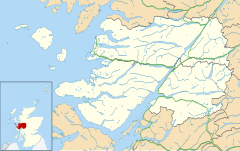Morvern (Scottish Gaelic: A' Mhorbhairne [ə ˈvɔɾɔ.əɾɲə]; "the sea-gap"), historically also spelt Morven, is a peninsula and traditional district in the Highlands, on the west coast of Scotland. It lies south of the districts of Ardgour and Sunart, and is bounded on the north by Loch Sunart and Glen Tarbert, on the south east by Loch Linnhe and on the south west by the Sound of Mull. The highest point is the summit of the Corbett Creach Bheinn which reaches 853 metres (2,799 ft) in elevation.
Morvern
| |
|---|---|
 | |
Location within the Lochaber area | |
| Population | 320 |
| Demonym | Morbhairneach |
| • Edinburgh | 190 mi (310 km) (road) 149 mi (240 km) (via Corran ferry) |
| • London | 567 mi (912 km) (road) 526 mi (847 km) (via Corran ferry) |
| Council area | |
| Lieutenancy area | |
| Country | Scotland |
| Sovereign state | United Kingdom |
| Post town | OBAN |
| Postcode district | PA80 |
| Dialling code | 01967 |
| Police | Scotland |
| Fire | Scottish |
| Ambulance | Scottish |
| UK Parliament | |
| Scottish Parliament | |
Administratively Morvern is now part of the ward management area of Lochaber, in Highland council area. It forms part of the traditional shire and current registration county of Argyll.
Morvern is approximately 250 square miles (650 square kilometres) in area, with a current population of about 320.
Prehistory and archaeology
editIn 2010, forestry planting by the then Forestry Commission Scotland led to the discovery of a Mesolithic stone tool scatter. Subsequent archaeology excavations also found evidence that people in the Bronze Age also used the same site.[1]
History
editMorvern was formerly known as Kinelvadon, which William J. Watson takes to be from Cineal Bhaodain, that is that lands of the Cenél Báetáin, a division of the Cenél Loairn named after Báetán, a putative great-grandson of Loarn mac Eirc. The Senchus fer n-Alban states that "Baotan has twenty houses".
The ruined Ardtornish Castle was in the possession of Somerled in the 12th century and then the Lords of the Isles, whose ownership was recalled in a poem of the same name by Sir Walter Scott. Kinlochaline Castle was once the seat of the MacInnes clan. It was largely destroyed by the army of Oliver Cromwell and restored in 1890.
Before the Highland clearances the population of Morvern was about 2500.
The history of the parish of Morvern in the 19th century has been detailed in Philip Gaskell's Morvern Transformed.
Some residents of St Kilda were relocated to Lochaline, the main village of Morvern, when the island was evacuated in 1930.
On 19th- and early 20th-century Ordnance Survey maps, Morvern is spelled "Morven".[2][3]
From 1845 to 1975 most of the peninsula formed the civil parish of Morvern.[4] The Kingairloch area in the east formed part of the civil parish of Ardgour. From 1930 to 1975 Morvern formed part of the landward district of Ardnamurchan in Argyll.
Present day
editFerries depart from Lochaline to the Isle of Mull. The Morvern Community Development Company (MCDC), the local development trust, was established in 1999. In 2010 it was announced that MCDC would receive support for a full-time development worker from Highlands and Islands Enterprise.[5]
The closure of the silica mine at Lochaline was announced in December 2008, with the loss of 11 jobs.[6] Lochaline Quartz Sand Ltd, a joint venture by Minerali Industriali and NSG Pilkington, reopened the mine in September 2012. [7] The mine produces high quality silica sand which is used in the production of solar panels.
Ardtornish, one of the largest estates in the area, received planning permission in 2010 for a new "township" of 20 houses at Achabeag, two miles (three kilometres) west of Lochaline.[8]
Nc’nean distillery is a Scotch whisky distillery in Drimnin on the Morvern peninsular.[9][10]
Notable people
editDuncan McNab, who was born at Achrinich in May 1820, was a Catholic missionary in Queensland and the Kimberley region of Western Australia.
Very Rev Norman Macleod (1838-1911), Moderator of the General Assembly of the Church of Scotland in 1900, was born in the manse at Morvern.[11]
See also
editNotes
edit- ^ "Vol 84 (2019): Mesolithic and later activity at North Barr River, Morvern | Scottish Archaeological Internet Reports". journals.socantscot.org. Retrieved 7 September 2021.
- ^ "View: Sheet 52 Tobermory - Ordnance Survey One-inch to the mile maps of Scotland, 1st Edition, 1856-1891".
- ^ "View: Sheet 52 Tobermory - Ordnance Survey One-inch to the mile maps of Scotland, 2nd Edition, 1885-1900".
- ^ Vision of Britain website
- ^ "HIE aim to bolster rural fragility" Local People Leading. Retrieved 24 June 2010.
- ^ "Highland community faces up to future after mine closure"[permanent dead link] Local People Leading. Retrieved 5 February 2009.
- ^ "History".
- ^ "Planning decision enables major new investment in Morvern" Archived 2010-10-14 at the Wayback Machine Ardtornish Estate. Retrieved 24 June 2010.
- ^ Morgan, Nick (2021). Everything You Need to Know About Whisky (But are Too Afraid to Ask). Ebury Publishing. ISBN 978-1529108750.
- ^ "Nc'nean". Scotch Whisky.com. Retrieved 10 October 2021.
- ^ Biographical Index of Former Fellows of the Royal Society of Edinburgh 1783–2002 (PDF). The Royal Society of Edinburgh. July 2006. ISBN 0-902-198-84-X. Archived from the original (PDF) on 4 March 2016. Retrieved 29 July 2017.
References
edit- Gaskell, Philip (1968) Morvern Transformed: A Highland Parish in the Nineteenth Century. Cambridge University Press.
- Maclean, Charles (1972) Island on the Edge of the World. Edinburgh. Canongate.
- Murray, W.H. (1977) The Companion Guide to the West Highlands of Scotland. London. Collins.
